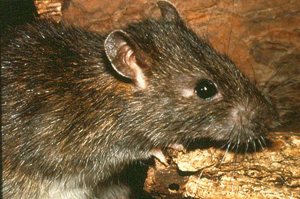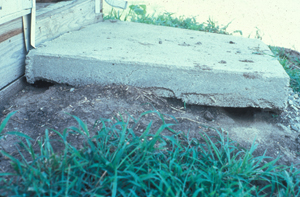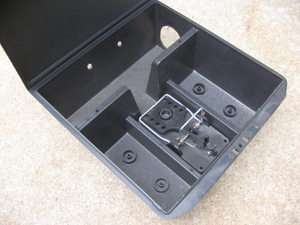G1737
Controlling Rats
This publication outlines how to control damage-causing and disease-carrying rats.
Stephen M. Vantassel, Extension Project Coordinator—Wildlife Damage
Scott E. Hygnstrom, Extension Specialist—Wildlife Damage
Dennis M. Ferraro, Extension Educator—Douglas/Sarpy County
|
The Norway rat (Rattus norvegicus) lives in and around cities, towns and farms throughout Nebraska (Figure 1). They are responsible for a great deal of damage, including eating and contaminating large amounts of feed, gnawing and burrowing in and around structures, and transmitting diseases to livestock and humans.
Rat Facts
Adult Norway rats have a body length of 7 to 12 inches, and weigh up to 1 pound. Their fur is coarse and can vary widely in color, from reddish brown to gray to black. They sport a naked, scaly tail that is 6 to 9 inches long. The native woodrat (Neotoma floridana) can be found in the wild, generally along rivers and streams in Nebraska. Woodrats, also known as packrats, are dark brown with a sparsely-haired tail that is bicolored. Nebraska currently is outside of the habitat range of roof rats, however, conditions may become favorable to their presence in the future.
Rats have keen senses of hearing, smell, taste and touch. They will climb to find food or shelter and can gain entrance to a building through any opening larger than 1/2 inch in diameter.
Rats eat about 10 percent of their body weight per day. They will eat almost anything, including cockroaches, but prefer grains, livestock feed and meat. Rats, unlike house mice, need to drink water. They consume 1 to 2 ounces each day, depending on environmental conditions.
Rats are prolific breeders and mating occurs primarily in the spring and fall. Females give birth to 6 to 12 young just 21 to 23 days after mating and average 4 to 6 litters per year. Offspring become sexually mature in about 90 days. Individuals usually live 5 to 12 months.
Inspecting for Rats
|
|||||||||||||||
Begin inspections by considering where rats may obtain shelter, food and water. Look in and around piles of debris, heavy vegetation, and clutter for the presence of burrows and trails. Den entrances will be 2 to 3 inches in diameter, with the ground worn smooth by frequent use (Figure 2). Rats may also dig additional openings, called “bolt holes” for emergency escape. Feces, gnawing and tracks may be found along runways between the den and sources of food and water (Table I). Rats avoid traveling in exposed areas, choosing to follow less visible routes. Since rats are highly adaptable, consider whether they are living in buildings, sewers, and other structures.
Rat Control
Effective and long-term control of rats requires an integrated approach. It is extremely rare for a rat infestation to be managed by means of a single control technique.
Sanitation
Reduce food, water and harborage necessary for rat survival. Whenever possible, clean up food spills, fix leaky faucets and modify bird feeders. Screen drainholes on the bottom of dumpsters to prevent rat entry. Stack packaged foods on pallets with adequate space left around and under stored articles to allow inspection for rat sign. Elevate stacked items, such as firewood and lumber. Remove piles of debris and keep grass trimmed around structures. Sanitation will reduce the number of activity points for rats and make other control efforts more effective. While sanitation is critical to the long-term management of rats, it is usually inadequate to control rats completely.
|
Rodent-Proof Construction
The most successful and permanent form of rat control is to “build them out” by eliminating their access to structures. Warehouses, grain mills, elevators, silos and corn cribs are especially vulnerable to rodent infestation. Ideally, locations where food is stored, processed or used should be rodent-proof.
Seal any openings larger than 1/4 inch to exclude both rats and mice. Openings where utilities enter buildings should be sealed tightly with metal or concrete. Wood, plaster and caulk will not prevent rats from gnawing, but are preferable to leaving the gap open. Secure floor drains and sewer pipes with tight-fitting grates that have openings less than a 1/4 inch in diameter. Doors, windows, and screens should fit tightly. It may be necessary to cover edges with sheet metal to prevent gnawing. Maintain a 24-inch wide weed-free zone around buildings constructed with 1-inch crushed gravel to reduce rodent pressure on the building.
Traps
Trapping is recommended for sensitive environments, such as schools, homes, hospitals or where rat populations are low. Trapping has several advantages: 1) it is non-toxic, 2) it permits the user to view his or her success, and 3) it allows for disposal of trapped rats, thereby eliminating odor problems which may occur when rodenticides are applied within buildings. While effective, trapping requires more skill and labor than most other methods. Prevent children, livestock, pets or desirable wildlife from accessing traps by placing them inside boxes or bait stations (Figure 3).
Available rat traps include simple, wood-based snap-traps, expanded trigger snap-traps, clamshell traps, glue boards and electric-shock traps. Traps can be purchased at most farm and pest control supply stores. Cage and multiple-catch traps are not recommended, as they are not as effective as other traps.
Traps may be used with or without bait. When trapping without bait, place snap traps so that the trigger end lays perpendicular to the rat’s path, thereby requiring the rat to step over the trigger (Figure 4). Set traps close to walls, behind objects, in dark corners and in other out-of-the-way locations that rats frequent. For baited traps, secure bait to the trigger with string or common glue. Peanut butter, nutmeat, marshmallow, hot dog, bacon and pepperoni are attractive baits.
Rats are neophobic, meaning they tend to avoid anything new found in their environment. It is common for rats to wait two weeks before interacting with traps and toxicants. Always perform a thorough site inspection before initiating any control techniques. Note all locations where rat sign is present. Familiarize rats with traps by placing unset traps where rat sign has been identified. Always use more traps than you think is necessary. Increase trapping success by using baited and unbaited traps. Set the traps when your baited traps require rebaiting. Secure all traps to prevent them from being moved. Check traps daily. Wear latex or vinyl gloves when removing dead rats. If a trap is successful in catching a rat, reset it in the same location.
Rat-sized glue boards are effective in catching juvenile and unhealthy rats. Place unsecured, glue boards along walls or in other areas where rats travel. Use covered glue boards in dusty areas and in food preparation sites. Use specially formulated “refrigerator use” glue boards when temperatures dip below 32°F.
Rodenticides
A wide variety of rodenticides (toxic baits) and fumigants are available for controlling rats. We recommend commercially-prepared materials to remove the need to handle the more hazardous concentrated toxicants. Remove and destroy all uneaten bait at the end of any baiting program. Never leave baits exposed; always place them inside bait stations. (See NebGuide G1646, Bait Stations for Controlling Rats and Mice.)
Anticoagulant rodenticides. Multiple-dose rodenticides (Table II) generally are considered safer than single-dose rodenticides. Many multiple-dose rodenticides are anticoagulants which cause death by causing internal bleeding. The active ingredients are used at very low levels, so bait shyness does not occur when using properly formulated baits.
| Table II. Anticoagulant rodenticides commonly used for rat control. | |||
| Common name | Mode of Action | Trade names | Percent active ingredient used in food bait |
| Brodifacoum | Anticoagulant | D-Con II, Enforcer, Final, Havoc, Jaguar, Ropax, Talon | 0.005 |
| Bromadiolone | Anticoagulant | Boothill, Contrac, Hawk, Maki | 0.005 |
| Chlorophacinone | Anticoagulant | Bonide, Enforcer V, JT Eaton, RoZol® | 0.05 bait 0.2 tracking powder |
| Difethialone | Anticoagulant | D-Con®, Enforcer, Generation, Hombre | 0.0025 |
| Diphacinone | Anticoagulant | Blue Death, Ditrac, Enforcer II, Ramik® Green, Tomcat, Ultrastop | 0.005 bait 0.2 tracking powder |
| Warfarin | Anticoagulant | Adios, Dean’s, Kaput | 0.025 |
Rats may feed on anticoagulant baits several times before death will occur. Fresh bait must be made available to rats continuously for at least two weeks, or as long as feeding occurs. Vitamin K is an antidote for anticoagulant toxicants.
Non-anticoagulant rodenticides. All non-anticoagulant rodenticides are Restricted Use Pesticides and can only be used by licensed pesticide applicators (Table III). They can quickly knock down a rat population and may be preferred where rats are abundant or where it is difficult to get rats to accept bait for several days in succession because of competing food items. Cholecalciferol is capable of causing death after a single feeding, but the rats do not die for several days.
| Table III. Non-anticoagulant rodenticides commonly used for rat control. | |||
| Common name | Mode of Action | Trade Names | Percent active ingredient used in food bait |
| Bromethalin | Central nervous system disruption | Alliance, Assault®, Fastrac, Gunslinger, Rampage®, Real-Kill, Tomcat | 0.01 |
| Cholecalciferol, Vitamin D3 | Hypercalcemia | Quintox®, Rampage®, Tomcat Vitamin D3 | 0.075 |
| Zinc phosphide | Heart paralysis | ZP® Rodent Bait, ZP® Rodent Bait AG | 2.0 bait
10.0 tracking powder |
Bait acceptance can be increased by “prebaiting” with untreated bait for several days before the rodenticide is offered. If acceptance of prebait is poor, do not apply toxic bait: change the bait material or its placement. Bait shyness can occur with some non-anticoagulants, such as zinc phosphide, so it is best to use them only once per year at any location.
Bait selection and placement
Applicators can choose from a variety of bait formulations, including grain baits, pellets and extruded and paraffin bait blocks. Pellets can be either loose or packaged in small plastic, cellophane or paper packets called “place packs.” These packs keep baits fresh and make it easy to place baits into burrows, walls, or other locations. Rats readily gnaw into place packs and feed on baits. Extruded blocks can be secured in bait stations, are very attractive to rodents, and are easy to use. Paraffin blocks are useful in damp locations such as sewers or gutters, where loose grain baits spoil quickly. While rats prefer loose baits and extruded blocks over paraffin blocks, loose baits are more likely to be moved to less secure locations and consumed by non-target animals. In light of this risk, the EPA is considering requiring that loose bait formulations be administered only by licensed pesticide applicators. To obtain a license, contact your local Extension Educator or the Nebraska Department of Agriculture or visit http://pested.unl.edu/pesticide/pages/index.jsp.
Anticoagulants also are available as sodium salts that are mixed into a water solution. Since rats require water daily, water baits can be particularly effective in grain storage structures, warehouses, and other locations where water is scarce.
Bait stations
Toxicants should always be placed out of the reach of children, pets, livestock and other non-target animals. Therefore, we highly recommend the use of bait stations when applying any toxic bait. They protect rodenticides from weather and provide a safeguard to people, pets, and other animals. Bait stations for rats should have at least two openings about 2 1/2 inches in diameter and should be large enough to accommodate several rats at a time. Place bait boxes next to walls (with the opening close to the wall) or in other places where rats are active. Label all stations clearly with the words “Caution —W Rat Bait” as a safety precaution.
Establish bait stations in or around the perimeters of buildings where it is impossible to exclude rodents. Place fresh anticoagulant bait in these stations to control invading rats before breeding populations become established. For more information, refer to NebGuide G1646, Bait Stations for Controlling Rats and Mice.
Fumigants
Fumigants occasionally are used to treat rodent burrows in outdoor situations. Aluminum phosphide tablets and gas cartridges are the most commonly used, registered fumigants for treating rat burrows. CAUTION: Fumigants are highly toxic to humans, livestock and other animals, and must not be used where occupants of a building could be exposed to the gases. Only appropriately licensed pest control operators should use fumigants in any buildings or enclosed structures. Applicators also must create a written fumigation plan before using aluminum phosphide pellets.
Safety precautions. Carefully follow all product label recommendations. In addition, certain general safety precautions should be followed. Consider all rodenticides dangerous enough to cause death and place baits where only rodents can access them. All rodenticides present some degree of hazard to humans, livestock, pets and other non-target animals.
Label all bait containers and bait stations clearly with appropriate warnings. Store unused bait, concentrates and fumigants in a locked cabinet out of the reach of children or animals. Pick up all accessible dead rats after a baiting or fumigant program. Use rubber gloves or tongs to pick them up and dispose of them by deep burial or incineration.
Repellents and Electronic devices. No repellents are known to be effective on rats. Given their adaptability, it is unlikely that an effective repellent will be found. Rats quickly become accustomed to regularly repeated sounds. Ultrasonic sounds, those above the range of human hearing, have very limited use because they are directional and do not penetrate behind objects. They also lose their intensity quickly with distance. Little evidence supports the use of electronic, sound, magnetic or vibration devices of any kind.
Predators. Although house cats, some dogs and other predators kill rats, they do not provide effective rat control in most circumstances. Rats often live in very close association with dogs and cats. Rat problems around homes are often related to the food, water, and shelter provided for pets.
If mouse control is also a problem, see NebGuide G1105, Controlling House Mice.
Acknowledgements
Much of this information was drawn from the previous NebGuide G1106, Controlling Rats by Scott Hygnstrom and Dallas Virchow.
Disclaimer Reference to commercial products or trade names is made with the understanding that no discrimination is intended of those not mentioned and no endorsement by University of Nebraska–Lincoln Extension is implied for those mentioned. |
Visit the University of Nebraska–Lincoln Extension Publications Web site for more publications.
Index: Wildlife Management
Wildlife Damage Control
Issued July 2007



